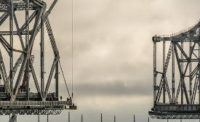

California's largest-ever dam removal project will take advantage of the area's unique topography to allow builders to divert permanently the Carmel River into a new channel.
Built in 1921 about 18.5 miles upstream of the Pacific Ocean in Monterey County, the 106-ft-tall San Clemente Dam is filled with 2.5 million cu yards of sediment. It is at risk of failure during an earthquake or probable maximum flood.
Under a $61-million design-build contract, crews with Granite Construction, Watsonville, will cut a 400-ft-long diversion channel through a small ridge that separates the Carmel River and the San Clemente Creek tributary a half mile above the dam.
Dam owner California American Water looked at multiple options, including buttressing. But state agencies and environmental groups sought a solution that would open up habitat for migrating steelhead trout and other species.
"Initially, we went through different alternatives for the removal process, but we always got stuck on the sediment," says Rich Svindland, vice president of engineering. "Ultimately, one of our employees came up with the idea to reroute the river around the sediment and leave the sediment in place." More expensive than buttressing, various public partners pitched in the additional funds to facilitate the dam removal and habitat restoration.
Engineers aren't sure how the creek bed will handle the increased flows because the soils have been hidden under the reservoir for so long, Svindland says.
Additional geotechnical work will be ongoing during the three-year project. Crews will excavate 380,000 cu yards of silt from the creek bed to add to the sediment along the old Carmel River channel.
The stockpiled material will be held in place during seismic events and floods, sandwiched between an upstream dike composed of rock excavated during the cut and, downstream, another rock-filled, engineered earthen dam.


